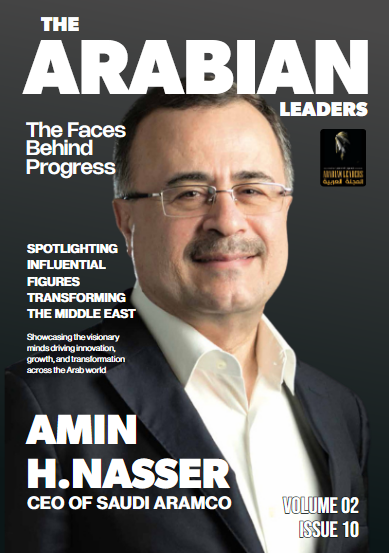In a Kingdom advancing with ambitious transformation, certain individuals play foundational roles. Engineer Suliman Almazroua stands as one such figure. While his name might not dominate headlines, his influence resonates throughout Saudi Arabia’s industrial landscape.
As the CEO of the National Industrial Development and Logistics Program (NIDLP), Almazroua has been instrumental in driving the Kingdom’s industrial ambitions under Vision 2030. His responsibilities span the development of the energy, mining, industry, and logistics sectors—requiring not just vision, but meticulous engineering of processes, policies, and long-term outcomes.
Almazroua operates beyond slogans, focusing on metrics, masterplans, and mechanisms. He builds for the long term, designs for resilience, and aligns his actions with national objectives. To understand his leadership is to understand how Saudi Arabia is constructing its economic future from the ground up.
A CAREER BUILT ON INFRASTRUCTURE AND INNOVATION
Engineer Suliman Almazroua’s ascent within Saudi Arabia’s development sector has been deliberate and steady. With a technical foundation and strategic mindset, his career reflects a deep integration of engineering, innovation, and policy execution. He is not merely a bureaucrat—he is a systems thinker. He translates technical ideas into government action and uses data as a compass for national development.
Before taking the helm at NIDLP, Almazroua held various impactful roles in strategic planning and execution. In each position, he exhibited a methodical approach to reform, a cautious yet confident embrace of innovation, and an unwavering dedication to the Kingdom’s goals. These roles built the foundation for his leadership of NIDLP, a cross-sectoral program that influences some of the most vital economic arteries in the country.
His technical expertise, coupled with a deep understanding of infrastructure development, made him the right figure to orchestrate a synchronized transformation across multiple sectors. He sees the bigger picture—but he also studies the bolts that hold the pieces together.
THE NIDLP BLUEPRINT: FROM AMBITION TO EXECUTION
At the center of Saudi Arabia’s push toward industrialization lies the National Industrial Development and Logistics Program. NIDLP is not simply an initiative—it is a national platform that connects ambition to application. It focuses on four key sectors: industry, mining, energy, and logistics.
Almazroua’s leadership in this space is marked by precision and depth. Rather than staying in the realm of abstract strategy, he moves deep into implementation—ensuring that project timelines are met, policy reforms are executed, and integration happens at every level. He does not lead from a distance. He leads from within the mechanisms of reform.
Under his watch, the program has made notable progress in facilitating coordination between public agencies, promoting private sector engagement, and growing industrial contributions to national GDP. What distinguishes this leadership is not noise or theatrics—it is the quiet, steady delivery of results.
ALIGNING INDUSTRY WITH NATIONAL INTEREST
For Almazroua, industry is not just about manufacturing numbers or output. It is about aligning national interest with practical capability. He emphasizes local content development not as a slogan, but as a strategic pillar—where procurement, manufacturing, and job creation align in a national loop.
His approach includes reducing barriers for local production, linking government procurement strategies with local capabilities, and offering structured incentives that de-risk manufacturing within the Kingdom. The vision is clear: create sovereign capabilities that support long-term economic resilience.
He also places high value on human capital development. Machines alone cannot drive transformation. Talent must be developed, transferred, and nurtured. His initiatives encourage vocational education, industrial innovation, and the cultivation of a skilled workforce capable of sustaining the transformation for generations to come.
LOGISTICS: THE SILENT ENGINE OF GROWTH
While energy and industry attract attention, it is logistics that often fuels the actual delivery of economic transformation. Almazroua views logistics not as an afterthought, but as the silent engine that enables all other sectors to function at full throttle.
Under his guidance, NIDLP has overseen projects aimed at upgrading port infrastructure, enhancing customs efficiency, and building multimodal transport systems that link production zones to domestic and international markets. From warehouses to rail links, from dry ports to digital platforms—each node in the network contributes to national competitiveness.
In this area, Almazroua’s strategy is rooted in global benchmarking and local application. He understands that without world-class logistics, Saudi Arabia’s industrial vision risks delay and inefficiency. That’s why his work often takes place behind the scenes—designing corridors, tracking freight flows, and enabling seamless commerce.
MINING: FROM UNDERGROUND POTENTIAL TO STRATEGIC VALUE
Among the sectors receiving new national attention is mining—a previously underexplored area now seen as a critical pillar of diversification. Almazroua has made it a priority within NIDLP’s agenda, recognizing that the future lies not just in extracting minerals, but in building an integrated value chain around them.
This vision includes refining geological data, modernizing mining laws, supporting local exploration companies, and encouraging value-added processing within the Kingdom. Whether it’s phosphate, bauxite, or rare earth minerals, the goal is to ensure that resources are not only discovered, but developed and monetized in ways that support national growth.
Almazroua’s strategy does not stop at extraction. It focuses on creating an ecosystem where mining drives regional development, supports advanced manufacturing, and aligns with global technology trends.
A STRATEGIC OPERATOR, NOT A CELEBRITY
Despite the magnitude of his portfolio, Almazroua maintains a low public profile. His work is not defined by social media appearances or public statements. It is defined by deliverables. He is seen by peers as a reliable negotiator, a calm strategist, and a policy executor with high credibility.
Those who work with him describe a leadership style that is focused, consistent, and deeply grounded in data. Meetings are marked by precision. Plans are accompanied by implementation schedules. There is little room for ambiguity, and even less for distraction.
He operates as a steward of national transformation. Not a brand ambassador. Not a headline chaser.
ALIGNMENT WITH VISION 2030
What sets Almazroua apart is not just his position—but the way he embodies the logic of Vision 2030 itself. His leadership reflects the plan’s balance between ambition and realism. He does not see the roadmap as marketing. He sees it as an engineering challenge, requiring calibration at every turn.
Every policy he drives, every reform he champions, feeds directly into the Kingdom’s vision of economic diversification, industrial sovereignty, and global integration. He is not an external observer of Vision 2030—he is one of its internal architects, designing systems and pathways that will outlast his tenure.
THE CHARACTER BEHIND THE STRATEGY
In person, Almazroua is known to be structured, disciplined, and reserved. He is not drawn to public recognition. Instead, he is focused on nurturing a culture of delivery. His teams are expected to operate with clarity, urgency, and accountability.
He believes in long-term planning. He values process maturity. And he pushes his teams to build institutions—not just programs.
In a region where leadership is often judged by visibility, Almazroua offers a different template: execution, institutional memory, and systemic alignment with national goals.
CONCLUSION: A LEGACY CAST IN SYSTEMS AND STRUCTURE
Engineer Suliman Almazroua may not command daily headlines or dominate public forums, but his fingerprints are on the systems, projects, and reforms that will define Saudi Arabia for decades to come.
He is not merely guiding Saudi Arabia’s industrial development—he is building its operational backbone. He works in policies, platforms, and projects that will outlive his tenure and shape the next generation.
His legacy will not be written in press releases. It will be embedded in supply chains, logistics hubs, industrial clusters, and mining cities. In a time of transformation, he is one of the engineers quietly making it permanent.








